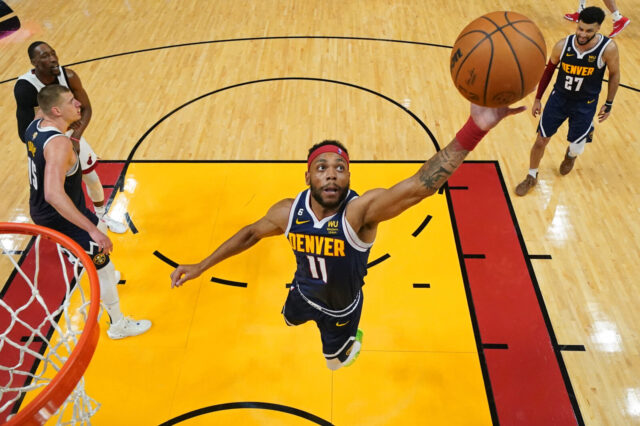If you’re not familiar with Film Fridays, each Friday, I’ll be looking at some recent Denver Nuggets’ games, lineups or something else from a film aspect to try and bring you a piece of content that you’re not getting somewhere else. Feel free to give any feedback positive or negative in the comments or find me on Twitter.
With the NBA draft less than a week away, this will be the final part of our breakout finder mini-series here on the Film Friday column. This week’s topic might be a bit of a surprise considering how long he’s been in the NBA, but Aaron Gordon still has room to grow and become a different version of the player he has been thus far. 2021-22 will be Gordon’s eighth NBA season, and he’ll still only be 26 for the entire year.
Since being drafted 4th overall in the 2014 NBA draft, Gordon has been one of the more polarizing young players in the league. He has struggled to put together a consistent 3-point jumper, and his offensive game plan has often been one that lacked a regular routine. His best source of offense was using his size and athleticism to get to the rim, but he would often settle for mid-range jumpers. On defense, he shows flashes of being an above-average on-ball defender, but he doesn’t always bring the consistency there.
Heading into the 2021-22 season, Gordon has a huge year ahead of him. He’s in the final year of his contract, and, if he’s able to put together another good year, he could lock up a deal that would keep him financially secure for the remainder of his physical prime. He showed potential to fit well in the Nuggets’ scheme prior to the litany of injuries the team sustained, and he’ll need to do that again this year to secure a payday in Denver or elsewhere.
3-Point Consistency
Prior to being traded to the Nuggets last season, Gordon was shooting 37.5 percent from 3-point range, which was the best mark of his career by a full 2.6 percent. Upon his Denver arrival, he shot 26.6 percent on 2.6 attempts per game during his 25 regular season games. The key aspect with Gordon’s 3-point shooting is that he doesn’t need to be able to knock down pull-up jumpers or shoot 40 percent from outside. Instead, if he can hit at least 35 percent from 3-point range as a spot-up shooter, that’s a win. On this play, Denver is pushing the ball in transition, and their best 3-point shooter on the floor, Michael Porter Jr., is back behind the play. Gordon rotates to the corner and hits the open look off of the pass from Facundo Campazzo. That’s all Denver needs from him.
Notice a difference between the two plays? On the first, Gordon is working off of the ball and hitting an open 3-point shot. On this one, Gordon has the ball in his hands and takes a side-step 3-point jumper falling away from the basket with a defender jumping at him with plenty of time on the shot clock for the offense to find a better look. These aren’t the types of looks that he should be hunting for especially when the Nuggets’ offense is at full health with better shooters on the floor.
Dunks Only
Last season, Gordon shot 88.9 percent on dunks. He shot 68.1 percent at the rim. From three feet out to the 3-point line, he shot 37.8 percent. Leave the mid-range jumpers to Porter, Jamal Murray and Nikola Jokic, and use your size to get to the rim and finish at the cup. This play typifies what Gordon should always be looking to do. Jokic pulls centers away from the rim which gives Gordon and other cutters better looks at the cup. Rather than hang out by the 3-point line, Gordon waits until the defense falls asleep, and he cuts in for the easy dunk.
What is the purpose of this shot? You’re less than two minutes into the game, and Gordon is attempting a turnaround jumper falling away from the rim less than five seconds into the shot clock against Portland’s best perimeter defender. Gordon is never going to be the player you’re running the offense through, and, while this game ultimately didn’t matter, the process over results remains true. Next year, Gordon needs to work to limit these types of plays from his offensive arsenal.
Defensive Consistency
I’m not sure what Gordon was expecting to happen on this play. He largely avoids the screen by C.J. McCollum, and, after getting over it, he doesn’t slide over to cut off Norman Powell’s driving lane. It’s possible he was hoping Monte Morris would switch to deny Powell’s drive, but Morris is dropping with McCollum the whole way. If the screen were better, Gordon would get more leeway, but McCollum never even makes contact with him. He needs to be better at staying in contact with his man with the athleticism he has. Allowing free drives like this also wears out Jokic more over the course of the game by forcing him to defend more at the rim.
There’s a big difference between this play and the previous one. Gordon doesn’t get screened, but he does get beat initially off the dribble after sliding to help on Damian Lillard before McCollum turns back and pulls up for the long jumper. Gordon doesn’t give up, and he gets back to cut off McCollum’s driving lane. He finishes the play off with a good contest on the jumper that forces the miss. If Gordon can just work on his consistency to stay in front of his assignments, he can be the lynchpin of Denver’s defense.
For those of you that are still here, remember to leave your feedback in the comments or over on my Twitter, and have a fantastic film-filled Friday.


